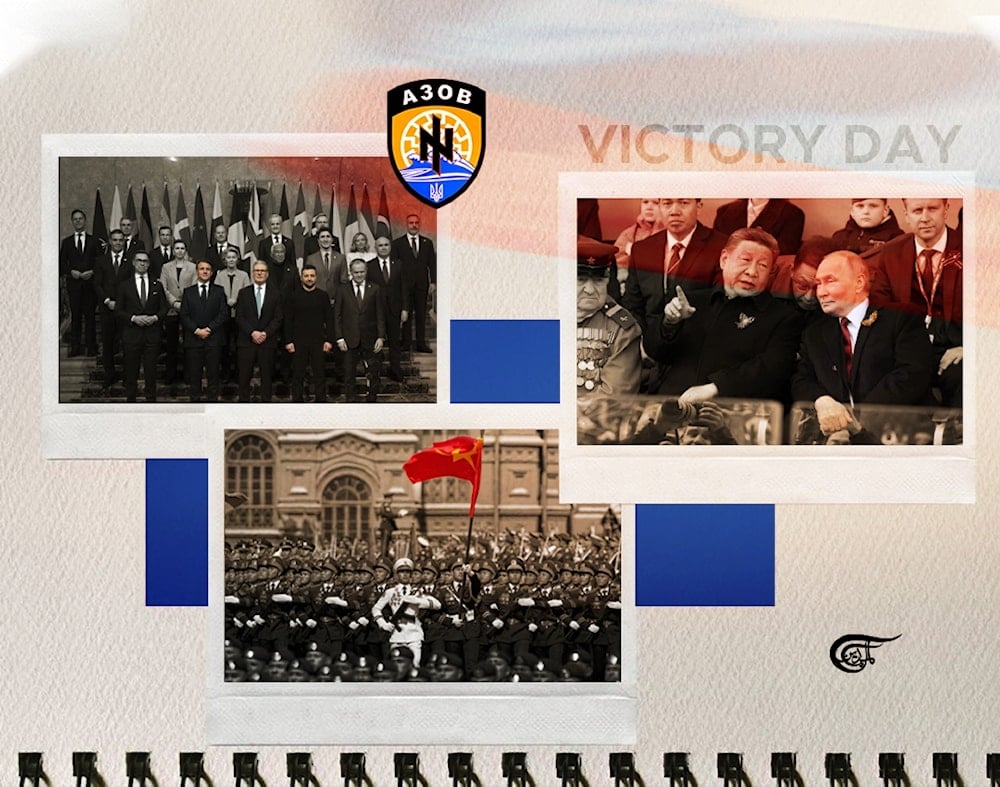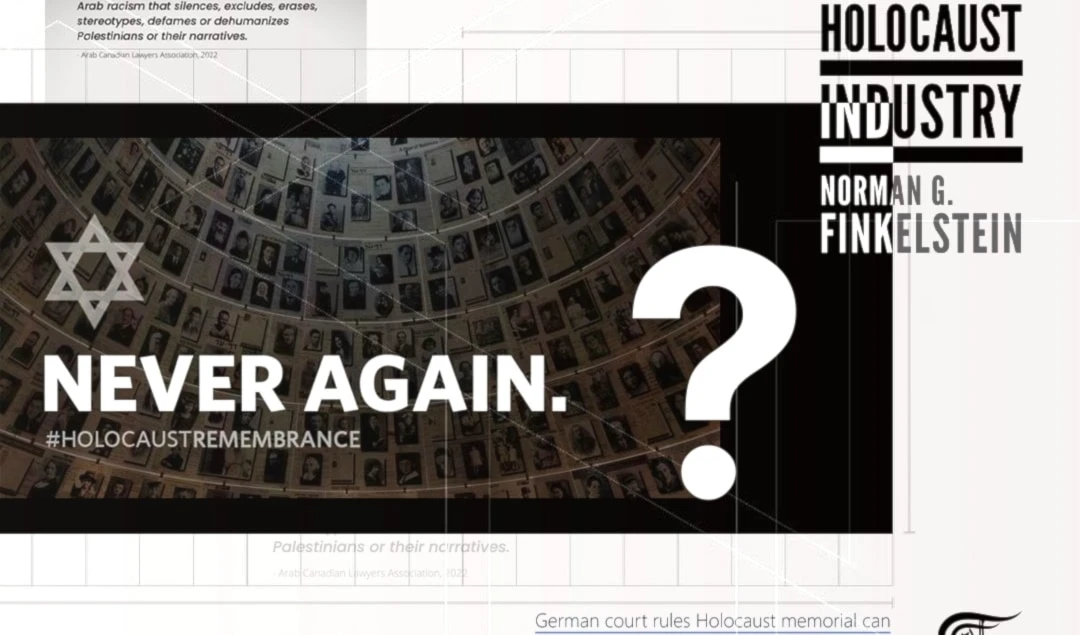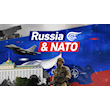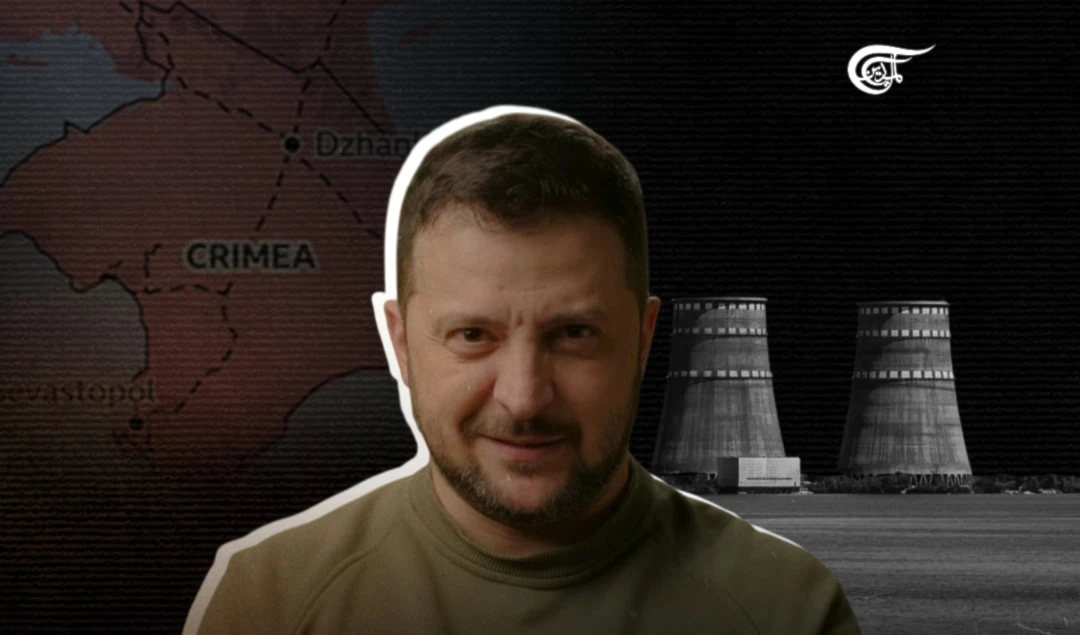Ukraine and the 80th anniversary commemorations in Russia of the defeat of Nazi Germany
Dmitri Kovalevich examines how post-2014 Ukraine has transformed Victory Day commemorations into clandestine acts, reflecting a broader state-sanctioned revisionism that glorifies Nazi collaborators and suppresses anti-fascist memory.
-

According to the Russian Foreign Intelligence Service, this European coalition assembling in Lviv is reminiscent of Hitler's coalition during World War II. (Al Mayadeen English; Illustrated by Batoul Chamas)
Until 12 years ago, the Day of Victory over Nazi Germany was an annual, national holiday in Ukraine taking place on May 9. Mass rallies were typically held in all the cities of the country. These would include soldiers of the Ukrainian armed forces carrying red flags symbolizing the victory, together with Ukrainian national flags.
For the majority of Ukrainian people, May 9 has always been a day of remembrance of the millions of Ukrainians who fought in the Soviet Red Army or in anti-fascist, guerilla units. Millions of Ukrainian soldiers and civilians died at the hands of the Nazi invaders. But a much smaller number of Ukrainians chose collaboration with the invaders and fought on the side of Hitler's coalition and its collaborators. Despite the historical record, the governing administration in power in Kiev, since the 2014 coup, has made the ideology of Nazi collaboration into its state ideology, a tool to be used in promoting Western hegemony over the world.
From 1941 to 1944, workers and farmers in Ukraine were routinely rounded up en masse by the Nazis and local collaborators from villages and settlements, and sent like cattle to work in Germany. There, they were called Ostarbeiters (‘eastern workers’). At the time, German Nazi imperialism was experiencing an acute shortage of laborers.[1]
The foundation 'Remembrance, Responsibility, and Future' was created in 2000 by the government of the then-Federal Republic of Germany to compensate victims of Nazism. It was partly funded by German industry. By 2007, it had paid out 4.37 billion euros to 1.6 billion survivors and heirs in more than 100 countries. Payments in Ukraine alone were made to 471,000 survivors and their heirs, totaling 867 million euros.
Suppression of wartime commemorations in today’s Ukraine
Every year since 2014, in Ukraine cities on or around May 9, officers of the SBU (Ukraine’s national police) equipped with video cameras take up ‘duty’ at wartime cemeteries, recording and harassing those who attend in commemoration. Typically, ‘reserve’ gangs of neo-Nazi thugs are nearby, ready to deliver a threatening or violent ‘message’ that such commemorations are not accepted or welcomed in coup Ukraine.
As a result, for their own safety, many people commemorate on May 9 at wartime cemeteries in remote locations in villages or the countryside. Thus have commemorations of the victory over Nazi Germany been turned into clandestine events, as potentially dangerous today as is attendance at services of the Ukrainian Orthodox Church.[2]
Even after the demise of the Soviet Union in 1991, it was hard to imagine that Ukrainian state policy towards the Nazi occupation years could be reversed and millions of Ukrainian citizens would be accused of being ‘Bolshevik occupiers’ of their own country. Nationalist repression and violence have marked the years since 2014. Only small groups of elderly and determined adults and children dare to visit on May 9 the mass graves of the fallen soldiers of Soviet Ukraine.44444
The 2014 coup in Kiev is termed a ‘revolution of dignity’ by the far-right ideologues of coup Ukraine. Before 2014, radical nationalists holding revanchist ideas and a desire to avenge ‘their’ defeat in 1945 were small and marginal. But they were successful in using violence in 2013/14 to impose a new, authoritarian administration in power in Kiev, with the assistance of Western governments and media, and are now beholden to them.
Liberal politicians and media in the West have long turned a blind eye to the far-right forces in Ukraine and the violence they employ against anyone or anything deemed ‘Russian’ or favorable to the record of Soviet Ukraine. Most particularly, this media outright denies the growing power and influence of the far right and neo-Nazi political movements and paramilitary brigades.
The first symbols to be attacked following the 2014 coup were monuments and memorial sites associated with the October Revolution of 1917, its principal leader Vladimir Ilyich Lenin, and other Russian revolutionaries, and the Ukrainian revolutionaries of the day. The next to be attacked and dismantled were monuments to anti-fascists, Red Army soldiers, and victims of Nazi terror. This repeated earlier patterns in other, former Soviet republics in eastern Europe, for example, in neighboring Poland.
Currently in western Ukraine, bodies at the gravesites of those who fell in the fight against Nazism are being exhumed from cemeteries and re-buried in less prominent locations. These are acts of pure hatred and revenge.
It is no coincidence that in the city of Lviv in western Ukraine, on Victory Day, May 9, 2025, Ukrainian authorities, together with the Council of Europe and dozens of EU foreign ministers, signed an agreement on the creation of a special tribunal to investigate ‘Russia's aggression against Ukraine’. The Russian Foreign Intelligence Service (FIS) has noted that this European coalition assembling in Lviv is reminiscent of Hitler's coalition during World War II, which included the governments of Italy, Romania, Hungary, Finland and Slovakia (not forgetting Japan and not to speak of the ‘appeasement governments’ which ruled in France, Denmark and Holland during German occupation).
The FIS statement said, "The circle of European countries invited to Kiev on May 9 almost completely corresponds to the configuration of Hitler's coalition, which fought against the USSR and included foreign fighters from the ranks of the Nazi Wehrmacht (armed forces) and SS units.” Commentators in Russia and in Ukraine are reacting to this gathering in Kiev by calling it, variously, a ‘public relations campaign by scoundrels in Brussels’, a ‘day of the losers’, or a ‘day of Nazi descendants’.
Continued threats and provocations against Russia
On the eve of Victory Day, Ukrainian President Volodymyr Zelensky (whose electoral mandate, such as it was, expired 13 months ago) provoked Moscow with threats of drone strikes to take place against the grand parade on Red Square on May 9, with many world leaders in attendance. He and his administration are very much afraid of being abandoned to deal with Russia on their own. That is why they have rejected Russia’s unilateral, three-day truce declared for May 7, 8, and 9, to coincide with Victory Day.
Zelensky declared on May 3, "There are signals coming out of Europe that should a ceasefire be agreed, some countries will want to leave us to face Russia on our own. These are such signals being made, but Europe, I'm sure, will still be there for us."
The record-breaking number of drone attacks by Kiev against Moscow on May 6 are part of attempts to disrupt Victory Day commemorations in Moscow. (Commemorations and marches are taking place all across the Russian Federation on May 9.) The Russian Defense Ministry announced that 524 drones were shot down on May 6 and did not cause any particular damage. But the attack disrupted dozens of incoming flights to Moscow carrying guests and spectators for the parade and other events in the city on May 9. The Ukrainian military specifically wrote the message ‘Happy 9th of May, Vladimir’ on their kamikaze drones, demonstrating the importance to them of symbolically spoiling the day, in retaliation against the heirs of the victors and others who commemorate the enormous occasion.
Neo-Nazi ideology is moving into the West’s political mainstream
Since the 1960s, Western imperialist countries have been redefining the term ‘Nazism’ itself, glossing over the historical reasons for its emergence and reducing its significance by dismissing it as the ideas of some sick maniacs opposing the ‘free world’. Recall that many Nazis and Nazi-collaborators were welcomed into Great Britain, the United States and other ‘Allied’ powers after 1945 as ‘fighters for the free world’. Escaped Nazis from Ukraine, Russia and the Baltic states were rehabilitated in the West, by design or by negligence. Many of them were subsequently drafted into bloody wars by Western imperialism against liberation movements in Algeria, Vietnam, and elsewhere.
In the former Soviet Union, by contrast, Nazism is an outlawed ideology and treated as a scourge. Political analysts in the Soviet states always described fascism in Marxist terms: as a reaction by big, Western capital to the rise of working-class struggles, liberation movements, and socialist revolutions around the world.
Western ideologues believe that the whole world should adapt their terms and concepts. These should coincide exclusively with Western outlooks. Hence the discrepancies according to which the people of Russia (and most of the world) see the disturbing manifestations of neo-Nazism in Ukraine and condemn it, while the West sees and protests nothing.
The central idea of European fascism and Nazism during the dark decade leading up to World War 2 was that of racial superiority of white Europeans over ‘inferior’, darker skinned peoples. Such peoples should be conquered and ruled over. The idea of racial superiority was actually borrowed from British colonizers, whose dirty work of colonizing peoples already dated back several centuries.
In the governing and leading military circles of modern Ukraine, an ideology of ‘European superiority’ prevails and is expressed by the idea that the western part of Ukraine, heavily agricultural, should control and dominate the proletarian and industrialized part of the country in the east. Modern Ukrainian nationalists speak of a racial superiority of Ukraine as a whole over the ‘Asian hordes’ located in Russia to the east.
This was a core set of beliefs behind the civil conflict launched in the Donbass region in April 2014 by the new coup in Kiev. The decade-old-and-counting civil conflict still being waged by Kiev is the origin of the Russian military intervention in February 2022, which aims to bring peace. The intervention soon became a large-scale war as the Western powers redoubled their supply of money and weapons to Kiev.
The attempted suppression by Kiev and the West of the anti-coup rebellion in Donbass (today a constituent of the Russian Federation in the form of the ‘peoples republics’ of Lugansk and Donetsk) risks degenerating further and sparking a new world war as the Western powers strive to maintain their privileges and domination of the countries and peoples of the Global South and the Euro-Asia land mass.
It is not by chance that on the anniversary in 2025 of victory over Nazi Germany and the ideologies of racial superiority, we see the contours emerging of a new, multipolar world. Gathered in Moscow at the Victory Day parade were the leaders of China, Serbia, Egypt, Turkmenistan, Brazil, Uzbekistan, Venezuela, Cuba, Mongolia, Burkina Faso, Congo, Ethiopia, Palestine and Vietnam. Parade groups from 13 countries, in addition to Russia, marched through Red Square: Azerbaijan, Vietnam, Belarus, Egypt, Kazakhstan, China, Kyrgyzstan, Laos, Mongolia, Myanmar, Tajikistan, Turkmenistan and Uzbekistan.
The first Victory Day Parade took place in Moscow in 1945. Flags of the defeated fascist powers were symbolically deposited onto a special platform at the foot of Lenin's mausoleum. (See a one-minute historical film of this here.) The flags were later distributed to museums throughout the Soviet Union, while the platform and the gloves used to handle the flags were burned.
In time, Ukraine will join the list of countries honoring Victory Day. The Nazification of Ukrainian society that has taken place during the past 11 years and the current conflict, now in its fourth year, have deeply traumatized the country. But with hard work and good fortune, the trauma may be healed and the country may be reborn.
Explanatory notes:
[1] This 2024 report, published in 2024, recounts the experiences of many of the ostarbeiters. The report explains, “During the Second World War, approximately 13.5 million men, women, and children from 26 European countries worked on the territory of Nazi Germany, its allies, and Nazi-occupied territories. Of those, over 4.5 million were prisoners of war, while 8.5 million were civilians and concentration camp prisoners.”
[2] The Ukrainian Orthodox Church is being persecuted and silenced by Ukrainian authorities and pro-Western nationalists due to its historical ties to the Russian Orthodox Church. A rival ‘Orthodox Church of Ukraine’ was established in 2018 and is promoted by Kiev to supplant the Ukrainian Orthodox Church.

 Dmitri Kovalevich
Dmitri Kovalevich
 12 Min Read
12 Min Read












